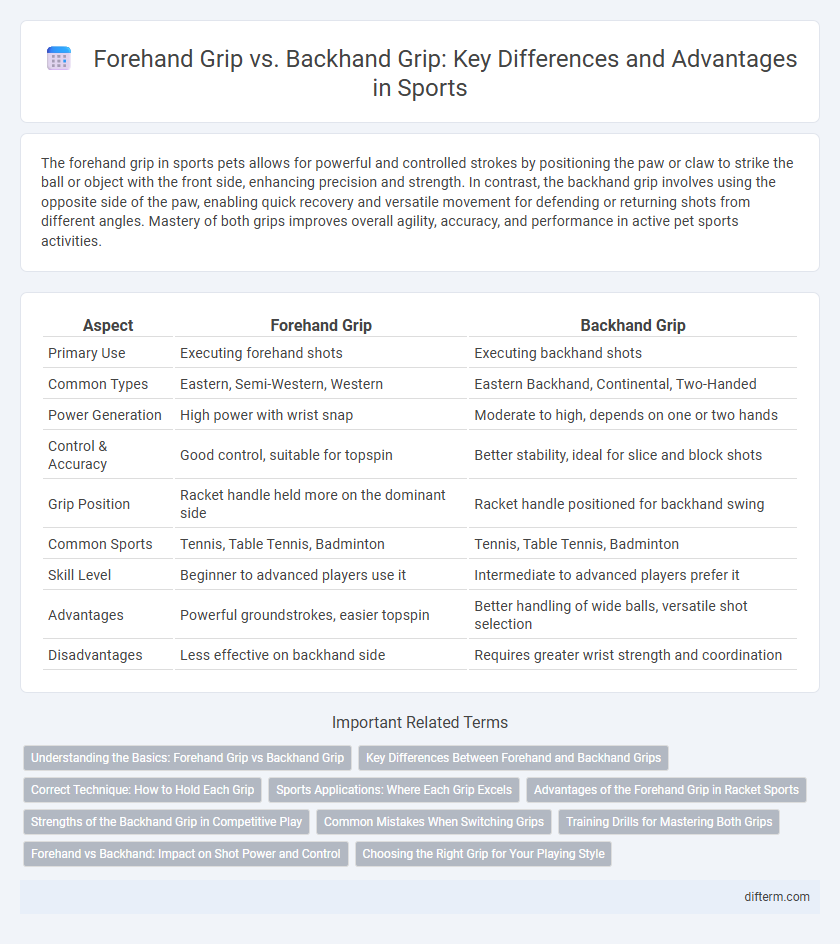The forehand grip in sports pets allows for powerful and controlled strokes by positioning the paw or claw to strike the ball or object with the front side, enhancing precision and strength. In contrast, the backhand grip involves using the opposite side of the paw, enabling quick recovery and versatile movement for defending or returning shots from different angles. Mastery of both grips improves overall agility, accuracy, and performance in active pet sports activities.
Table of Comparison
| Aspect | Forehand Grip | Backhand Grip |
|---|---|---|
| Primary Use | Executing forehand shots | Executing backhand shots |
| Common Types | Eastern, Semi-Western, Western | Eastern Backhand, Continental, Two-Handed |
| Power Generation | High power with wrist snap | Moderate to high, depends on one or two hands |
| Control & Accuracy | Good control, suitable for topspin | Better stability, ideal for slice and block shots |
| Grip Position | Racket handle held more on the dominant side | Racket handle positioned for backhand swing |
| Common Sports | Tennis, Table Tennis, Badminton | Tennis, Table Tennis, Badminton |
| Skill Level | Beginner to advanced players use it | Intermediate to advanced players prefer it |
| Advantages | Powerful groundstrokes, easier topspin | Better handling of wide balls, versatile shot selection |
| Disadvantages | Less effective on backhand side | Requires greater wrist strength and coordination |
Understanding the Basics: Forehand Grip vs Backhand Grip
Mastering the forehand grip and backhand grip is fundamental for effective stroke play in tennis. The forehand grip typically involves the continental or eastern grip, allowing powerful and controlled strokes, while the backhand grip often uses the eastern or continental grip to facilitate precision and versatility. Understanding these grips enhances stroke mechanics, improves shot accuracy, and optimizes overall court performance.
Key Differences Between Forehand and Backhand Grips
Forehand grip typically involves positioning the base knuckle of the index finger on the third bevel of the racket handle, enabling powerful topspin and control on the dominant side. Backhand grip varies between one-handed and two-handed styles, generally placing the hand(s) on the second or first bevel, which allows for greater reach and versatility in shot angles. The forehand grip maximizes wrist snap and power, while the backhand grip emphasizes stability and precision during cross-court and down-the-line shots.
Correct Technique: How to Hold Each Grip
The correct forehand grip involves placing the base knuckle of the index finger on the third bevel of the racket handle, allowing for powerful and controlled strokes. For the backhand grip, especially the one-handed version, the base knuckle typically rests on the first bevel, providing stability and precision in backhand swings. Mastering these grips enhances shot accuracy, spin control, and overall tennis performance.
Sports Applications: Where Each Grip Excels
The forehand grip excels in tennis and badminton for powerful, controlled strokes that maximize offensive play and spin generation. Backhand grip is essential in sports like table tennis and squash, providing precision and versatility for defensive shots and quick directional changes. Each grip optimizes performance by enhancing stroke mechanics suited to specific gameplay scenarios and tactical demands.
Advantages of the Forehand Grip in Racket Sports
The forehand grip in racket sports offers greater power and control, enabling players to generate stronger, more precise shots with less effort. It allows for faster swing speeds and improved wrist flexibility, which enhances shot variety and spin. This grip also facilitates better court coverage by enabling smoother transitions between offensive and defensive strokes.
Strengths of the Backhand Grip in Competitive Play
The backhand grip provides enhanced control and stability, allowing players to execute precise and powerful shots from the non-dominant side in competitive tennis and badminton. Its ergonomic design reduces wrist strain, enabling sustained performance during extended rallies and rapid directional changes. Mastery of the backhand grip offers strategic versatility, essential for countering aggressive opponents and maintaining court coverage.
Common Mistakes When Switching Grips
Common mistakes when switching between forehand and backhand grips include improper wrist positioning, leading to reduced control and power. Players often fail to adjust finger placement accurately, causing inconsistent shot execution and increased unforced errors. Neglecting grip pressure variation can result in decreased racket maneuverability and compromised stroke effectiveness.
Training Drills for Mastering Both Grips
Effective training drills for mastering forehand and backhand grips include repetitive shadow swings to build muscle memory and improve grip consistency. Incorporating multi-angle ball feeding drills enhances adaptability and strengthens wrist control for both grips. Progressive resistance exercises using grip trainers further develop hand strength, facilitating smoother transitions between forehand and backhand strokes during gameplay.
Forehand vs Backhand: Impact on Shot Power and Control
The forehand grip generally allows for greater shot power due to increased wrist flexibility and racquet head speed, enhancing offensive plays. In contrast, the backhand grip prioritizes control and precision, enabling players to execute accurate, consistent shots under pressure. Mastery of both grips enables balanced performance, combining powerful forehand strokes with controlled backhand responses in competitive sports.
Choosing the Right Grip for Your Playing Style
Selecting the right forehand or backhand grip fundamentally enhances stroke control and power reflecting your playing style. A semi-western forehand grip provides topspin and aggressive baseline play, while an eastern backhand grip favors flat shots and quick volley responses. Tailoring grips to your strength areas promotes consistency, precision, and tactical advantage in matches.
Forehand Grip vs Backhand Grip Infographic

 difterm.com
difterm.com